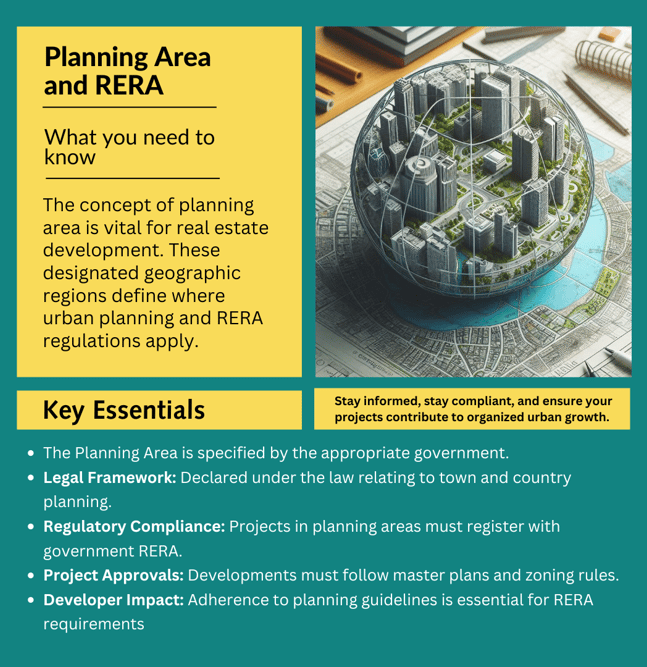𝗪𝗵𝗮𝘁 𝗗𝗲𝘃𝗲𝗹𝗼𝗽𝗲𝗿𝘀 𝗡𝗲𝗲𝗱 𝘁𝗼 𝗞𝗻𝗼𝘄 𝗔𝗯𝗼𝘂𝘁 𝗣𝗹𝗮𝗻𝗻𝗶𝗻𝗴 𝗔𝗿𝗲𝗮𝘀 𝗮𝗻𝗱 𝗥𝗘𝗥𝗔
Explore how designated planning areas under RERA shape real estate projects, ensuring they meet regulatory standards, zoning laws, and environmental guidelines. This guide provides essential insights on approvals, compliance, and developer responsibilities to help projects align with master plans and protect consumer interests.
Pinky G Bhonsley
8/19/20243 min read


𝗨𝗻𝗱𝗲𝗿𝘀𝘁𝗮𝗻𝗱𝗶𝗻𝗴 𝗣𝗹𝗮𝗻𝗻𝗶𝗻𝗴 𝗔𝗿𝗲𝗮𝘀 𝗶𝗻 𝗥𝗘𝗥𝗔
Key Insights for Developers and Investors
Introduction
In Karnataka, the concept of a "planning area" holds significant importance for real estate developers, investors, and homebuyers. Under the Karnataka Real Estate Regulatory Authority (RERA), planning areas are geographically designated zones identified for urban planning and development. These areas dictate where and how development can occur, providing a regulatory framework that ensures projects align with Karnataka’s master plans and zoning regulations. This blog delves into the key aspects of planning areas under Karnataka RERA, covering definitions, regulatory requirements, and the impact on real estate projects.
What is a Planning Area?
A planning area in Karnataka RERA refers to specific regions—such as cities, towns, or suburban areas—earmarked for structured urban planning and development. These areas often include multiple local bodies, such as municipal corporations, municipalities, or town panchayats, ensuring a cohesive approach to land use, infrastructure, and environmental standards. For developers, understanding these areas is crucial since all real estate projects within a planning area fall under RERA’s jurisdiction, mandating compliance with urban planning guidelines and regulatory standards.
Key Points about Planning Areas in Karnataka RERA
1. Definition and Scope
Coverage: Planning areas span cities, towns, and nearby regions, integrating various local governing bodies. These areas facilitate organized urban development, guiding how land is utilized for residential, commercial, industrial, and green spaces.
Purpose: By defining planning areas, Karnataka RERA sets boundaries for where development can occur, ensuring sustainable growth and community well-being. This allows local authorities to manage urban expansion efficiently and responsibly.
2. Regulatory Compliance
RERA Registration: All real estate projects within a planning area must be registered with Karnataka RERA, ensuring they adhere to land use policies, zoning, environmental regulations, and other legal requirements.
Ensuring Standards: Compliance ensures projects meet Karnataka's high standards for environmental sustainability, safety, and transparency, enhancing accountability among developers and protecting consumer interests.
3. Approval of Projects
Necessary Approvals: Before launching any real estate project, developers must obtain approvals from relevant authorities within the planning area, including permits based on the master plan and zoning regulations.
RERA Registration Prerequisite: Only after obtaining necessary permissions can a project be registered with RERA. This process safeguards the interests of homebuyers and ensures projects are sustainable and legally sound.
4. Role of the Urban Development Authority (UDA)
Oversight and Implementation: In planning areas, an Urban Development Authority (UDA), such as the Bangalore Development Authority (BDA), manages the implementation of the master plan. The UDA monitors land allocation, enforces zoning regulations, and oversees infrastructure development.
Development Coordination: The UDA’s involvement ensures that developments align with the area’s designated use, whether residential, commercial, or industrial, helping to prevent unregulated construction and urban sprawl.
5. Master Plans
Guiding Framework: Each planning area operates according to a master plan, a blueprint detailing land use policies, zoning rules, infrastructure expansion, and environmental standards.
Developer Compliance: Adherence to the master plan is essential, as it serves as a reference point for project approvals. Developers must ensure their plans align with land use policies, including road networks, green spaces, and residential zoning.
6. Impact on Developers
Project Boundaries and Compliance: Developers must ascertain that their projects fall within planning area limits. Furthermore, they must comply with all RERA regulations, covering project timelines, financial transparency, and adherence to the master plan.
Consumer Protection and Accountability: Karnataka RERA mandates disclosures on project finances and timelines to protect consumer interests. Developers within planning areas must meet these criteria, assuring homebuyers that projects will be completed as promised and according to legal standards.
Why Planning Areas Matter for Developers, Investors, and Homebuyers
For anyone involved in the Karnataka real estate market, a clear understanding of planning areas and their regulatory frameworks is vital. Planning areas under RERA not only provide structure and accountability for real estate projects but also foster transparency, which is essential for sustainable development. Here's how each stakeholder benefits:
Developers: Ensuring compliance with planning area regulations reduces legal risks, enhances project credibility, and builds trust with homebuyers.
Investors: The security that RERA-compliant projects offer—through transparency, timely project completion, and adherence to master plans—makes planning area projects more attractive investments.
Homebuyers: The planning area framework assures buyers that their investments are secure, sustainable, and legally compliant, with projects aligning with broader urban planning goals.
Conclusion
Planning areas under Karnataka RERA are more than just designated zones; they represent a commitment to organized, transparent, and sustainable urban growth. For developers, understanding the boundaries and regulations of these areas is essential for lawful project execution and successful market positioning. Compliance with planning area regulations is not just a legal obligation but a pathway to sustainable urban development that benefits communities, investors, and homebuyers alike. By adhering to RERA’s planning area guidelines, developers can contribute to Karnataka's vision of a well-planned and balanced real estate sector, enhancing both consumer protection and the quality of urban life.
Contacts
D No.1344, Situated at Nazarbad Mohalla, Vasanth NagaraLayout, Alanahalli, Mysore Karnataka-570028.
Get in touch
reach@sankalplc.in
+91 99012 41849


